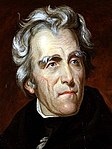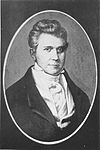1822–23 United States Senate elections
The 1822–23 United States Senate elections were held on various dates in various states. As these U.S. Senate elections were prior to the ratification of the Seventeenth Amendment in 1913, senators were chosen by state legislatures. Senators were elected over a wide range of time throughout 1822 and 1823, and a seat may have been filled months late or remained vacant due to legislative deadlock.[1] In these elections, terms were up for the senators in Class 2.
| |||||||||||||||||||||||||
16 of the 48 seats in the United States Senate (plus special elections) 25 seats needed for a majority | |||||||||||||||||||||||||
|---|---|---|---|---|---|---|---|---|---|---|---|---|---|---|---|---|---|---|---|---|---|---|---|---|---|
| |||||||||||||||||||||||||
 Results: Federalist hold Dem-Republican hold Legislature Failed To Elect | |||||||||||||||||||||||||
| |||||||||||||||||||||||||
The Democratic-Republican Party continued to maintain almost complete control of the Senate.
Factions
At the very end of the next Congress, the 1824 United States presidential election led to a contingency election, decided by the Congress. In that election, Senators split into factions in support of William H. Crawford, Andrew Jackson, or John Quincy Adams and Henry Clay. Even though that election wasn't held until more than two years after the Senate elections in this article, those factions are noted below as "Crawford," "Jackson," or "Adams-Clay."
Results summary
Senate party division, 18th Congress (1823–1825)
- Majority party: Democratic-Republican (42–43)
- Minority parties: National Republican & Federalist (4–5)
- Total seats: 48
Change in composition
Before the elections
Composition after the January 24, 1822 Delaware special election.
| DR1 Del. Gain | DR2 | DR3 | DR4 | ||||||
| DR14 | DR13 | DR12 | DR11 | DR10 | DR9 | DR8 | DR7 | DR6 | DR5 |
| DR15 | DR16 | DR17 | DR18 | DR19 | DR20 | DR21 | DR22 | DR23 | DR24 |
| Majority → | DR25 | ||||||||
| DR34 Ky. Ran | DR33 Ill. Ran | DR32 Ga. Ran | DR31 Ala. Ran | DR30 | DR29 | DR28 | DR27 | DR26 | |
| DR35 La. Ran | DR36 Me. Ran | DR37 Miss. Ran | DR38 N.J. Ran | DR39 N.C. Ran | DR40 R.I. Ran | DR41 S.C. Ran | DR42 Tenn. Ran | DR43 Va. Ran | DR44 N.H. Retired |
| F1 | F2 | F3 Mass. Ran | F4 Del. | ||||||
Result of the regular elections
| DR1 | DR2 | DR3 | DR4 | ||||||
| DR14 | DR13 | DR12 | DR11 | DR10 | DR9 | DR8 | DR7 | DR6 | DR5 |
| DR15 | DR16 | DR17 | DR18 | DR19 | DR20 | DR21 | DR22 | DR23 | DR24 |
| Majority → | DR25 | ||||||||
| DR34 Ky. Re-elected | DR33 Ill. Re-elected | DR32 Ga. Re-elected | DR31 Ala. Re-elected | DR30 | DR29 | DR28 | DR27 | DR26 | |
| DR35 La. Re-elected | DR36 Me. Re-elected | DR37 Miss. Re-elected | DR38 N.J. Re-elected | DR39 R.I. Re-elected | DR40 Va. Re-elected | DR41 N.H. Hold | DR42 N.C. Hold | DR43 S.C. Hold | DR44 Tenn. Hold |
| F1 | F2 | F3 Mass. Re-elected | V1 Del. F Loss | ||||||
| Key: |
|
|---|
Race summaries
Bold states link to specific election articles.
Special elections during the preceding Congress
In these special elections, the winners were seated during 1822 or before March 4, 1823; ordered by election date.
| State | Incumbent | Results | Candidates | ||
|---|---|---|---|---|---|
| Senator | Party | Electoral history | |||
| Delaware (Class 1) | Vacant | Outerbridge Horsey (F) had resigned March 3, 1821. New senator elected January 24, 1822. Democratic-Republican gain. |
| ||
| Ohio (Class 3) | William A. Trimble | Democratic-Republican | 1819 | Incumbent died December 13, 1821. New senator elected January 29, 1822. Democratic-Republican hold. |
|
| Massachusetts (Class 2) | Harrison Gray Otis | Federalist | 1816 | Incumbent resigned May 30, 1822, to run for Mayor of Boston. New senator elected June 5, 1822. Successor was also elected to the next term, see below. Federalist hold. |
|
| Alabama (Class 3) | John W. Walker | Democratic-Republican | 1819 | Incumbent resigned December 12, 1822, due to failing health. New senator elected December 12, 1822. Democratic-Republican hold. |
|
| Maryland (Class 1) | William Pinkney | Democratic-Republican | 1819 (special) 1821 | Incumbent died February 25, 1822. New senator elected December 17, 1822. Democratic-Republican hold. |
|
| Virginia (Class 2) | James Pleasants | Democratic-Republican | 1819 (special) | Incumbent resigned December 15, 1822, to become Governor of Virginia. New senator elected December 18, 1822. Successor was later re-elected to the next term, see below. Democratic-Republican hold. |
|
Races leading to the next Congress
In these regular elections, the winner was seated on March 4, 1823; ordered by state.
All of the elections involved the Class 2 seats.
| State | Incumbent | Results | Candidates | ||
|---|---|---|---|---|---|
| Senator | Party | Electoral history | |||
| Alabama | William R. King | Democratic-Republican | 1819 | Incumbent re-elected December 12, 1822. |
|
| Delaware | Nicholas Van Dyke | Federalist | 1817 | Legislature failed to elect. Federalist loss. Incumbent would later be re-elected late in 1824. | [data missing] |
| Georgia | Nicholas Ware | Democratic-Republican | 1821 (special) | Incumbent re-elected in 1822 or 1823. |
|
| Illinois | Jesse B. Thomas | Democratic-Republican | 1818 | Incumbent re-elected in 1823. |
|
| Kentucky | Richard Mentor Johnson | Democratic-Republican | 1819 (special) | Incumbent re-elected in 1823. |
|
| Louisiana | Henry Johnson | Democratic-Republican | 1818 (special) | Incumbent re-elected in 1823. |
|
| Maine | John Chandler | Democratic-Republican | 1820 | Incumbent re-elected in 1823. |
|
| Massachusetts | James Lloyd | Federalist | 1808 (special) 1808 1813 (Resigned) 1822 (special) | Incumbent re-elected as an Adams-Clay Federalist in 1822. Winner was also elected to finish the current term, see above. |
|
| Mississippi | Thomas Hill Williams | Democratic-Republican | 1817 | Incumbent re-elected in 1823. |
|
| New Hampshire | David L. Morril | Democratic-Republican | 1816 | Incumbent retired. New senator elected in 1823. Democratic-Republican hold. |
|
| New Jersey | Mahlon Dickerson | Democratic-Republican | 1817 | Incumbent re-elected in 1823. |
|
| North Carolina | Montfort Stokes | Democratic-Republican | 1816 (special) 1816 | Incumbent lost re-election. New senator elected in 1822. Democratic-Republican hold. |
|
| Rhode Island | Nehemiah R. Knight | Democratic-Republican | 1821 (special) | Incumbent re-elected in 1823. |
|
| South Carolina | William Smith | Democratic-Republican | 1810 (special) 1816 | Incumbent lost re-election. New senator elected in 1822. Democratic-Republican hold. |
|
| Tennessee | John Williams | Democratic-Republican | 1815 (special) | Incumbent lost re-election. New senator elected October 28, 1823.[5] Democratic-Republican hold. |
|
| Virginia | John Taylor of Caroline | Democratic-Republican | 1822 (special) | Incumbent re-elected in 1823. Winner was also elected to finish the current term, see above. |
|
Special elections during the next Congress
In these special elections, the winners were elected in 1823 after March 4; ordered by election date.
| State | Incumbent | Results | Candidates | ||
|---|---|---|---|---|---|
| Senator | Party | Electoral history | |||
| New Jersey (Class 1) | Samuel L. Southard | Democratic-Republican | 1821 (Appointed) 1820 | Incumbent resigned March 4, 1823, to become U.S. Secretary of the Navy. New senator elected November 12, 1823. Democratic Republican hold. |
|
Alabama
Alabama (regular)
Incumbent William R. King was first elected in 1819. He was reelected with the votes of over 41% of the legislators, defeating William Crawford, former agent to the Choctaw nation John McKee, and another candidate named William King.
| |||||||||||||||||||||||||||||
| |||||||||||||||||||||||||||||
Alabama (special)
Incumbent John Williams Walker resigned on December 12, 1822, due to failing health. He would die in April of the following year. William Kelly was elected in his place with 56.65% of the votes of state legislators, defeating state representative John McKinley.
| |||||||||||||
| |||||||||||||
Delaware
Delaware (regular)
The Delaware General Assembly did not elect a candidate to the United States Senate.
Delaware (special)
Federalist incumbent Outerbridge Horsey retired in the 1820/1821 Senate elections. The Delaware General Assembly failed to elect a successor. Caesar Augustus Rodney, the U.S. representative for Delaware's at-large congressional district and a nephew of founding father Caesar Rodney, was elected late.
Georgia
Incumbent Democratic-Republican Nicholas Ware was reelected in 1823.
Illinois
Incumbent Democratic-Republican Jesse B. Thomas was reelected in 1823.
Kentucky

Incumbent Democratic-Republican Richard Mentor Johnson was reelected in 1823.
Louisiana
Incumbent Democratic-Republican Henry S. Johnson was reelected in 1823
Maine
Incumbent Democratic-Republican John Chandler was reelected in 1823.
Maryland (special)
| ||||||||||||||||
80 members of the Maryland General Assembly | ||||||||||||||||
|---|---|---|---|---|---|---|---|---|---|---|---|---|---|---|---|---|
| ||||||||||||||||
Incumbent Democratic-Republican William Pinkney died on February 25, 1822. Congressman Samuel Smith, a Democratic-Republican, was elected to the seat on December 17, 1822.[6]
Massachusetts
Massachusetts (regular)
Incumbent Federalist James Lloyd was reelected in 1822 after being first elected in a special election (see below).
Massachusetts (special)

Incumbent Senator Harrison Gray Otis resigned on May 30, 1822, to run for Mayor of Boston. Former senator James Lloyd, a Federalist was elected on June 5, 1822.
Mississippi
Incumbent Democratic-Republican Thomas Hill Williams was reelected in 1823.
New Hampshire
Incumbent Democratic-Republican David L. Morril retired. Governor of New Hampshire Samuel Bell was elected as a Democratic-Republican.
New Jersey
New Jersey (regular)
Incumbent Democratic-Republican Mahlon Dickerson was reelected in 1823.
New Jersey (special)
Incumbent Democratic-Republican Samuel L. Southard resigned on March 3, 1823, to become the U.S. Secretary of the Navy. Democratic-Republican Joseph McIlvaine was elected to finish his term on November 12, 1823.
North Carolina
Incumbent Democratic-Republican Montfort Stokes was defeated for reelection by John Branch, a fellow Democratic-Republican, in 1822.
Ohio (special)
Incumbent Jeffersonian Republican William A. Trimble died on December 13, 1821, at the age of 35. Governor of Ohio, Ethan Allen Brown, was elected to finish Trimble's term.
Rhode Island
Incumbent Democratic-Republican Nehemiah R. Knight was reelected in 1823.
South Carolina
Incumbent Democratic-Republican William Smith lost reelection to Democratic-Republican Robert Y. Hayne.
Tennessee
Former senator and general Andrew Jackson defeated incumbent John Williams in the election for Senate. Jackson was put up as the Jacksonian candidate after Williams decided to support William H. Crawford in the 1824 Presidential Election.[7] Williams was endorsed by Davy Crockett.[8] Jackson's return to the senate after nearly 25 years out of office marks the second longest gap in service in U.S. Senate history. Jackson would resign two years later in 1825, and eventually be elected president in 1828.
| |||||||||||||||||||
60 legislators 31 votes needed to win | |||||||||||||||||||
|---|---|---|---|---|---|---|---|---|---|---|---|---|---|---|---|---|---|---|---|
| |||||||||||||||||||
Virginia
Virginia (regular)
After being elected in the special election (see below), incumbent John Taylor was reelected in 1823.
Virginia (special)
Incumbent James Pleasants resigned on December 15, 1822, to become Governor of Virginia. Former senator John Taylor, a Democratic-Republican, was elected with 51.8% of the votes of legislators over former congressmen Henry St. George Tucker and John Tyler, both Democratic-Republicans.
| |||||||||||||||||
| |||||||||||||||||
See also
References
- Party Division in the Senate, 1789-Present, via Senate.gov









